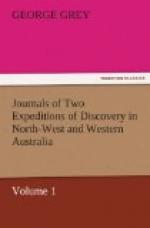April 6.
I found a very easy route over the sandstone, quite passable in fine weather, but after rains, I think, from the marshy nature of the ground, that it would present some difficulty. The marsh itself was perfectly passable, could without any difficulty be drained, and consisted of good and fertile land. A remarkable circumstance connected with it was the great depth of the beds of its streams, the banks in some places being fourteen feet above the existing water level, whilst I could observe no signs of the water having ever risen to that height. In the afternoon I once more struck our old track, which I quitted again in the evening. We halted a few hundred yards from two remarkable heaps of stones of the same kind as those I have before mentioned.
CURIOUS NATIVE MOUNDS OR TOMBS OF STONES.
April 7.
This morning I started off before dawn and opened the most southern of the two mounds of stones which presented the following curious facts:
1. They were both placed due east and west and, as will be seen by the annexed plates, with great regularity.
2. They were both exactly of the same length but differed in breadth and height.
3. They were not formed altogether of small stones from the rock on which they stood, but many were portions of very distant rocks, which must have been brought by human labour, for their angles were as sharp as the day they were broken off; there were also the remains of many and different kinds of seashells in the heap we opened.
My own opinion concerning these heaps of stones had been that they were tombs; and this opinion remains unaltered, though we found no bones in the mound, only a great deal of fine mould having a damp dank smell. The antiquity of the central part of the one we opened appeared to be very great, I should say two or three hundred years; but the stones above were much more modern, the outer ones having been very recently placed; this was also the case with the other heap: can this be regarded by the natives as a holy spot?
We explored the heap by making an opening in the side, working on to the centre, and thence downwards to the middle, filling up the former opening as the men went on; yet five men provided with tools were occupied two hours in completing this opening and closing it again, for I left everything precisely as I had found it. The stones were of all sizes, from one as weighty as a strong man could lift, to the smallest pebble. The base of each heap was covered with a rank vegetation, but the top was clear, from the stones there having been recently deposited.
PASS IN MOUNTAIN RANGE.
In the afternoon we proceeded on our route, travelling nearly north. After marching some distance we traversed at right angles a variety of under-features terminating in sandstone cliffs, but the hills on our right were composed of the same black rock as the chain in which Mount Lyell lies. Private Mustard being ill, I gave him my horse and tried to walk, but injured myself materially by so doing. We were obliged to encamp at the head of a large mangrove inlet.




